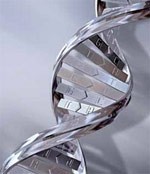Using DNA to Build Nanomaterials

By Lisa Paitz Spindler
Nature is full of patterns, from the crystalline lattices of diamonds and silicon salt to the symmetry of the DNA double-helix and the concentric circles of tree rings. Scientists at Northwestern University are now using other Nature's lattice structure to build complex nanoparticles with applications for medicine, energy generation and electronics.
A team of scientists led by Professor Chad A. Mirkin is substituting nanoparticles for atoms and DNA for bonds, to create atomic lattice structures in patterns that mimic arrangements found in nature. "We are building a new periodic table of sorts," said Mirkin. "Using these new design rules and nanoparticles as 'artificial atoms,' we have developed modes of controlled crystallization that are, in many respects, more powerful than the way nature and chemists make crystalline materials from atoms."
A Cure for Cancer?
One of the most exciting potential uses for these structures is targeting cancer cells at a genetic level, without damaging healthy cells. Mirkin's DNA-laced gold nanostructures could potentially latch on to cancer cells and block the production of proteins that keep such cells from dying. The particles essentially make cancer cells mortal.
While the Northwestern team's project concentrated on gold nanoparticles, this method could also be used with a range of substances. The team is now working on a way for the lattice structures to self-replicate, similar to how biologists use the polymerase chain reaction (PCR) to amplify a single strand of DNA and generate millions of copies. PCR has been used to analyze minute strands of ancient DNA and also to diagnose early-stage leukemia. With a PCR model of nanostructure replication, Mirkin hopes to one day develop software that will enable scientists to choose numerous particle-DNA pairs and build almost any structure. . . on demand.
Classroom Discussion
- What are some other examples of structure and symmetry in nature?
- What are some other applications of nanomaterials in other fields, e.g., construction?

